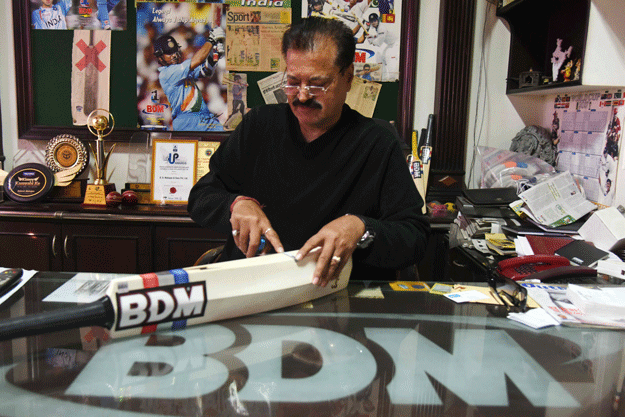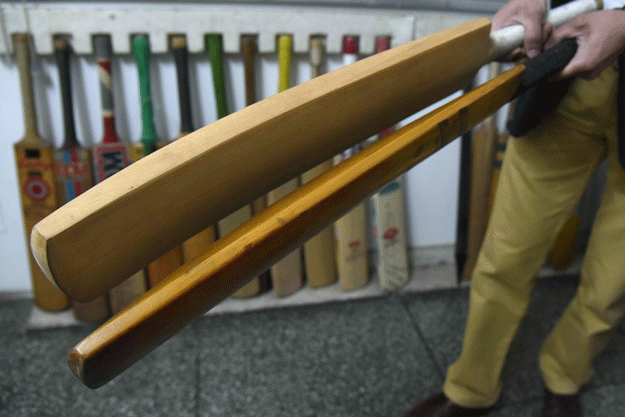
As factory worker Jitender Singh carves another slab of thick willow, he insists that proposals to limit the size of cricket bats won’t tame the big hitters.
“I don’t think the thickness matters,” said Singh. “It’s more about the balance of the bat and the talent of the batsman.”
He has made bats for many leading players including South Africa’s AB de Villiers, who holds the record for the fastest hundred in an ODI — off just 31 balls.
“We can provide a thick or thin blade but it’s the batsman who knows best how to use it,” he said at the factory of BDM, one of India’s leading cricket gear suppliers, in Meerut in India’s northern state of Uttar Pradesh.
The World Cricket committee of the Marylebone Cricket Club (MCC), who are the guardians of the game’s rules and regulations, recommended last month that limitations be placed on the thickness of bats. They believe bigger weapons have made it too easy to smash fours and sixes.
“(The) balance of the game has tilted too far in the batsman’s favour. The time has come to limit the sizes of bat edges and depths,” said the committee.
It suggested a maximum thickness of 40 millimetres at the edge of the bat rising to 67mm at the spine during its two-day meeting in India’s Mumbai.

Thirty years ago a batsman’s weapon of choice averaged 30mm to 32mm thick at the edge but today’s bigger bats are a chunky 45mm to 50mm. The only current size restrictions are on length and width.
They state that the overall length of the bat shall not be more than 38 inches [96.5 centimetres] and the width of the bat shall not exceed 4.25 inches [10.8 centimetres] at its widest part.
The proliferation of the high-octane T20 format in which matches are won primarily on the number of boundaries struck has fuelled the rush to bigger bats. However, some claim that modern batsmen are simply bigger, stronger and more athletic and would be hitting more boundaries anyway.
Jatin Sareen, managing director of SS Sports, also in India’s bat-making hub of Meerut, agrees with Singh that limiting a bat’s size won’t make any difference.
“I don’t agree [with the MCC proposal]. Nor will it give any benefit to the game. Bats will have the same power as they have [now],” he told a foreign news agency.
The cricket bat has evolved significantly down the years from the original paddle-like shape to the popular scooped-back variety to today’s familiar boat-shaped bat.
Rakesh Mahajan, co-owner of BDM, insists that through the changes the constant has remained the batsman’s skill.

“English and Australian players didn’t use boat-shaped bats. Now everybody is using them,” he said. “Skill remains the same, you see. It’s still the batsman’s talent that gets him runs and not the thickness of the bat.”
Cricketers have long experimented with different weapons. Back in 1979 Australia’s Dennis Lillee controversially came out to bat in a Test with an aluminium bat which was subsequently banned.
Countryman Matthew Hayden wielded a “mongoose” in the 2010 Indian Premier League which had a long handle and short blade, while West Indian Andre Russell is using a unique black bat in Australia’s Big Bash League.
Stories of India great Mansur Ali Khan Pataudi in the 1960s picking up whatever bat was nearest before walking out to the crease are legendary. But 50 years on, cricketers are involved in every aspect of the manufacture of their bats.
“They come down to the factory to discuss their needs and demands,” said Sareen.
If the MCC main committee agrees to the limit the thickness of bats then the regulations will become part of the laws of the game from October next year.
Former India fast-bowler Chetan Sharma doesn’t expect the game to shift suddenly away from the batsmen.
“You can’t bring back days of WG Grace-like [thin] bats. If those bats came back then bowlers would have an advantage,” he told a foreign news agency. “If a batsman has class, he will score a boundary. As a fast-bowler I don’t see much delight in this. For a spinner maybe the sixes and fours may reduce.”




